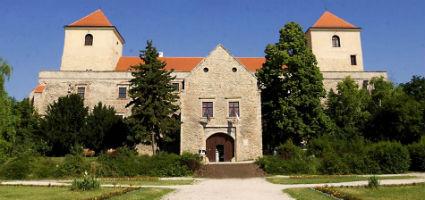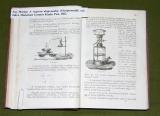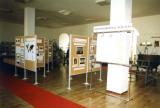2025. July 19. Saturday
Hungarian Museum for Science, Technology and Transport - Chemistry Museum - Várpalota
 |
Address: 8100, Várpalota Thury-vár
Phone number: (88) 575-670
E-mail: vegymuz@vegyeszetimuzeum.hu
Opening hours: 01.01.2011-31.07.2011.: Closed
|
To represent the relics of chemistry and chemical industry is one of the hardest tasks of the technical museums. Most of the former instruments of the alchemists were distroyed. Scholars of scientific chemistry worked by using such abstract terms, which are very hard to represent in a museum. Even modern chemical industry is not so easy to display, since chemical processes involve such huge devices that can only be shown on photographs.
However, Hungarian chemistry and chemical industry deserve a museum, since we have always had such methods, techniques, schools and scholars (Nobel prize) that were outstanding in the whole world.
The Hungarian chemist Museum was founded by the Ministry of heavy industry. The museum received its operation licence in 1963. Its purpose is to explore the history of the chemical industry and protect, scientifically process and rexhibit its relics.
The museum is not only unique to our country, but is the only independent chemist museum of Mid-Europe. It was established on the site of a ruined castle in Várpalota. Várpalota has a central role in the Hungarian chemical industry and is easily accessible from Budapest.
The castle has been renovated by mostly the Ministry of heavy industry and the chemical industry enterprises. The town also supported these works by helping with the finances. At present farther renovation works are being carried out.In 1990 the castle was declared as part of the National Heritage.
The museum objective collection numbers over 9.000 pieces. Its industry historical documentation consists of 44.000 documents. The library has over 19.000 volumes. The mining industry historical collection reminds visitors of the 100 years-old coal mining industry of Várpalota.
The exhibitions of the museums began right beyond the entrance to the castle. The 20th century factories of the former Hungária Vegyimuvek are represented on the sides of the entrance corridor. At the end of the corridor there can be seen one of the oldest technical relics of the domestic chemical industry: a cast-iron potash-cooking basin. Few people know that the first manufactured product of the Hungarian chemical industry was the pot-ash (potassiumcarbonate), which was exported for foreign textile and glass industry.
However, Hungarian chemistry and chemical industry deserve a museum, since we have always had such methods, techniques, schools and scholars (Nobel prize) that were outstanding in the whole world.
The Hungarian chemist Museum was founded by the Ministry of heavy industry. The museum received its operation licence in 1963. Its purpose is to explore the history of the chemical industry and protect, scientifically process and rexhibit its relics.
The museum is not only unique to our country, but is the only independent chemist museum of Mid-Europe. It was established on the site of a ruined castle in Várpalota. Várpalota has a central role in the Hungarian chemical industry and is easily accessible from Budapest.
The castle has been renovated by mostly the Ministry of heavy industry and the chemical industry enterprises. The town also supported these works by helping with the finances. At present farther renovation works are being carried out.In 1990 the castle was declared as part of the National Heritage.
The museum objective collection numbers over 9.000 pieces. Its industry historical documentation consists of 44.000 documents. The library has over 19.000 volumes. The mining industry historical collection reminds visitors of the 100 years-old coal mining industry of Várpalota.
The exhibitions of the museums began right beyond the entrance to the castle. The 20th century factories of the former Hungária Vegyimuvek are represented on the sides of the entrance corridor. At the end of the corridor there can be seen one of the oldest technical relics of the domestic chemical industry: a cast-iron potash-cooking basin. Few people know that the first manufactured product of the Hungarian chemical industry was the pot-ash (potassiumcarbonate), which was exported for foreign textile and glass industry.
|
Programmes
|
|



